LA VIRGEN DE GUADALUPE
"Dark hair and dark eyes, just like me."
In 1531, recently after the Spanish razed the breathtaking Aztec capital Tenochtitlan to make Mexico City AND had destroyed their sacred places and outlawed their religion, an Indian named Juan Diego was walking through the hills just north of the new city. The region is arid, rocky and inhospitable for most life forms. Desert. As he passed the hill of Tepeyac, once the home of Tonanzin, temple for the gentle goddess of earth and corn, he smelled a heavenly fragrance and heard celestial music. He stopped in the midst of a brilliant light, and the blessed Mother Mary emerged, robed in blue and gold and rose. But this incarnation of the Virgin had Indian features.
It took Juan Diego three times to convince the bishop to build a shrine on the ground where she had appeared. Finally Mary told Juan to pick the Castillian roses that were miraculously growing at the place. He filled his tilma, or white muslin cape, with the roses and went to the bishop. Upon arriving at the Cathedral of Tlatelolco the Spanish fathers could see the image of the Blessed Virgin emblazoned on the tilma, the blossoms pouring out at the image of her feet. This was good enough for them.
[recap, paraphrased from a Barbara Lyons article]
----
Our own Virgen de Guadalupe story began with a mid afternoon comida. The day before the festivities actually start, the city is expectant. The worshippers will form lines to enter the church late that night. The next two days will be filled with celebration--children dressed as Juan Diego or a female contemporary parade from El Catedral at the Zocolo to el parque Llano very close to our house. The park will be filled with vendors of food and plastic chinese-made anythings and pirated videos and CDs and more food and, of course, the rides. More on the rides later.
As we sat for the comida, the bouganvilla flowers (bugambilia here) continued to flow from their trellis over our outdoor table in the courtyard. The meal was fairly simple for our usual formal sit downs. Frijoles, arroz, aguacate, quesadillas, que mas? No one can quite remember, because at one point I went to help Leland scoot his chair in for the 5th time and I stepped on what I thought was a bugmabilia flower. But it was a bit harder than a flower. And out of my peripheral vision, it now seemed to be rolling back and forth in a way that made me swing the chair away and gasp. It was the largest worm I have ever seen. Nobody saw it walk in, and no one invited it. I had just stepped on its head. El gusano grande! 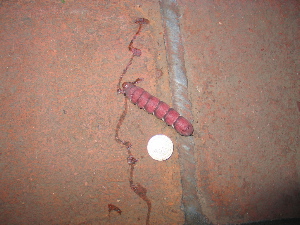
The thing was about the size of an italian sausage. The coin you can't quite make out was a 10 Peso piece, between a quarter and half dollar in size. The worm's underside was like an uncooked lobster tail. A purple fantail pattern on the bottom. Twelve stumpy legs, each like a plantar's wart. Writhing and draining a streak of clear fluid. This, of course, was no miracle, but it was amazing.
The next day Tracy and I went to Ocotlan for our second time. Previously we had gone for a very busy market day around the Dia de los Muertos during which Alta had her digital camera stolen. That day had been fairly close to a total washout for me and I wasn't looking forward to returning to Ocotlan, but a friend of ours, David Riker, was showing his feature film La Ciudad at the exconvento of Ocotlan's Santo Domingo church. The church that had been restored by Rodolfo Morales. David invited us to go with him and his wife Elizabeth and daughter Leila. Though the film was our main attraction, they promised the best chile rellenos on the planet. This happened to be the case.
One of the comedors lining the main plaza, this one seemed simple enough. But I had forgotten that Elizabeth had told us the daughter of the owner looked like Frida Kahlo. They were running low on chile rellenos, but made more for us. The owner's daughter, Beatriz, arrived with her own daughters about 20 minutes later. She did indeed look like Frida, but you can judge for yourself.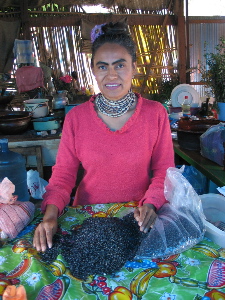
Their comedor stand has two beautiful moles (mole-ays are mixtures of chocolate, chile, and other spices), rojo-red and one that was nut brown. We tried them both as we waited for the chile rellenos. The chile rellenos at this spot are made with Chile de Agua instead of the usual, milder, poblano chiles. The added spice makes all the difference. I'm biased, of course. I like it spicy.
David was led off for a radio interview. It's a funny story in spanish, but the gist of it goes something like this. Morales's nephew came to get David from Beatriz's comedor. David was looking forward to another relleno, but knew he had to go. En route to the radio station, they're a bit late. They run into the radio host outside in his truck. He's drunk. The host says, "You're early, don't worry, we won't start until 5pm. You don't have to come over until then. What time is it?" David says, "530p." So they go to the studio immediately. The man is seriously drunk. Once they arrive, David finds out that the interview is going to be a marathon. One hour. Also, he discovers that he can barely understand his host. The man is talking fast and slurring like crazy. Something like "Mumblemermemerenemenomubmlelemumble, what do you think, David?" In spanish. So David has to guess at what the question was and guess at what the answer should be. For an hour. The whole time, the host is kicking back mezcals, praising Rodolfo Morales, saying that Morales used to use mezcal as a creative tool, etc. and offering shots to David and Morales's nephew who hasn't had a drink in 12 years. Around the time that the film was supposed to start, back at the exconvento, David started getting subtle looks from Morales. Taking his cue, he started to wrap up, gave his standard "Thank you to the Morales Foundation, the fine people of Ocotlan, etc." When he had finished, the host made sure that David knew that they had 12 minutes left in the hour and he wasn't going to rob his audience of the promised, full one hour show! David made it back in plenty of time to show the film that night.
We went to the church doors to look in on the activity before the film. It was busier than normal. But, then again, it was the festival of the Virgen de Guadalupe. And, in a mixture of dread and thrills, we saw that there would be a quince anos celebration that night during the film. Quince anos is a celebration of a girl's 15th birthday. And in Ocotlan, they celebrate with a big brass band.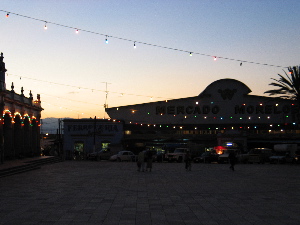
It wasn't long until it was dark. Dark enough to begin the film. The exconvento courtyard began to fill. David's film went without a hitch--for about quince minutos. Then the band and the one-loud-boom fireworks were lit up at the same time. At one point in the film, which is about Mexican and Central American immigrants in NYC, one of the characters says to the other in a very intimate scene in a quiet garden, "Wait, wait, do you hear that? It's like we're back in Mexico." We of course could barely hear this line over the band and the bombs. And it was just like we were in Mexico, too. Through all of this, the film was a treat to watch. Check it out.
On the way home we bought amazingly good ice creams sandwiches. Chocolate and gelato. How did they get here? And as we're driving back we start to feel like we're doing the wrong thing. We should stay out as long as possible. Leila might go to sleep, don't you think? We stop on the side of the road to let a band pass in pitch dark (except for headlights). A perfect band marching down a perfect Mexican street. A little further we see the turnoff for San Martin Tilcajete, the small town famous for their wooden animal carvings called alebrijes. In almost a fit of withdrawl, we pulled to the side of the main San Martin church. Not as restored as the Ocotlan church, but a popular place for the people of the town on this night. Some people were streaming out of the new wooden doors, out of the fluorescent lights into the chill night air. I think we saw the girl dressed as the Virgen de Guadalupe waiting. But for what? Just then, the San Martin band began to play. Just as loudly as the quince aņos band in Ocotlan. And a woman walked into the middle of the park in front of the church. It was there that she lit fire to the fireworks resting anxiously on her head in a large basket. For the next 10 minutes she danced and twisted as the full strength fireworks shot off her head and into the trees and sky, and sometime glancing off the ground (oops) and the band played.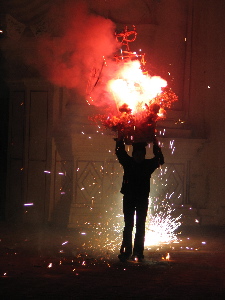
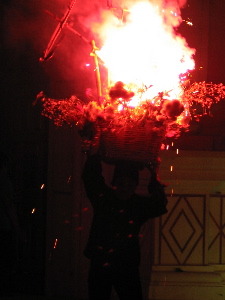
After the missiles landed and smoked themselves out, we went into the church. A few people were left. And is the case with so many people in the state of Oaxaca, one young man asked us where we were from. Did we come from the US, for he, too, had been in the US and has a brother there. We marveled at the gruesome depiction of the life and death of Christ. The old worm-eaten doors were on display, too. Like relics themselves from a time of spanish rule, eaten by the truth of the land and the insects and the people. As we walked back to the car, more greetings. "You should go down the road to the rest of the celebration," the guy with a brother in the states said. "If you think tonight was fun, you should come back for Noche Buena (Christmas Eve)." I couldn't help think immediately of how the tables turn if these open people, most gracious hosts, if they would tromp unannounced and uninvited into the middle of a Christmas eve party in any town east of the Pacific and north of the Rio Grande.
After dragging our feet to the car, we left. David and I sat in the front seats. Elizabeth finished her ice cream sandwich. Watching for topes (speed bumps) in the dark, David warned Tracy that he and I both were going to learn the tuba and get steady work as freakishly tall white tuba players in as many bands as possible. The tuba doesn't really appeal to me. There's never much flourish in the playing of a tuba. But I could learn.

0 Comments:
Post a Comment
<< Home